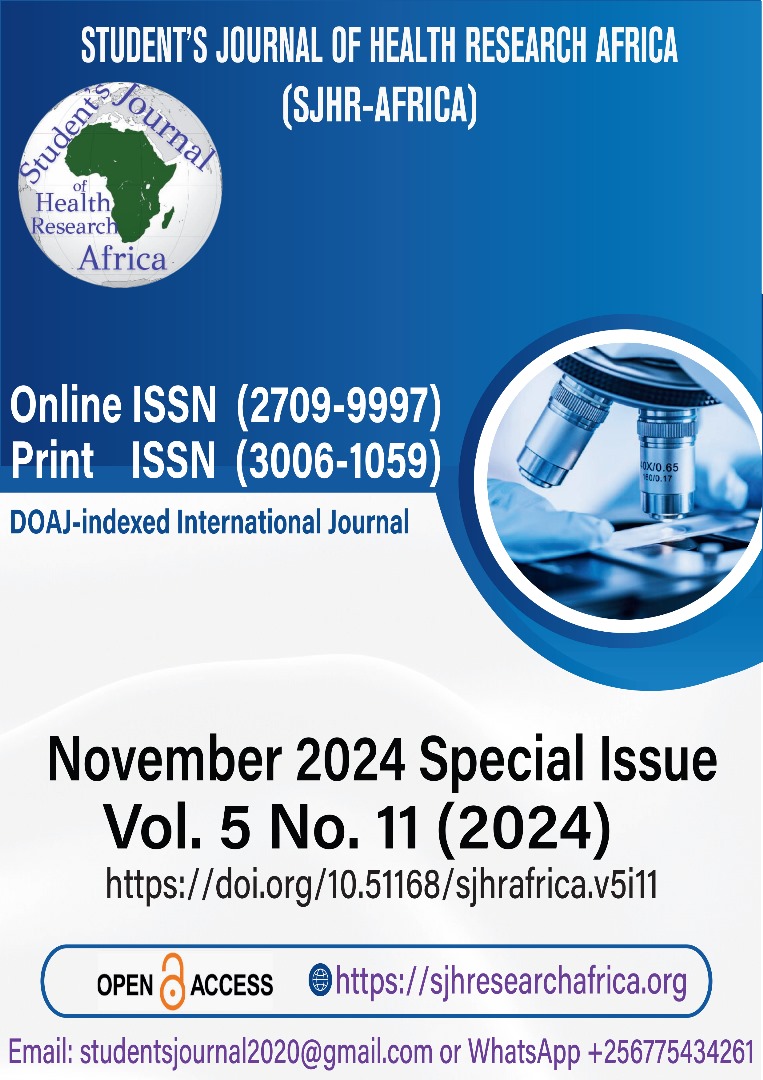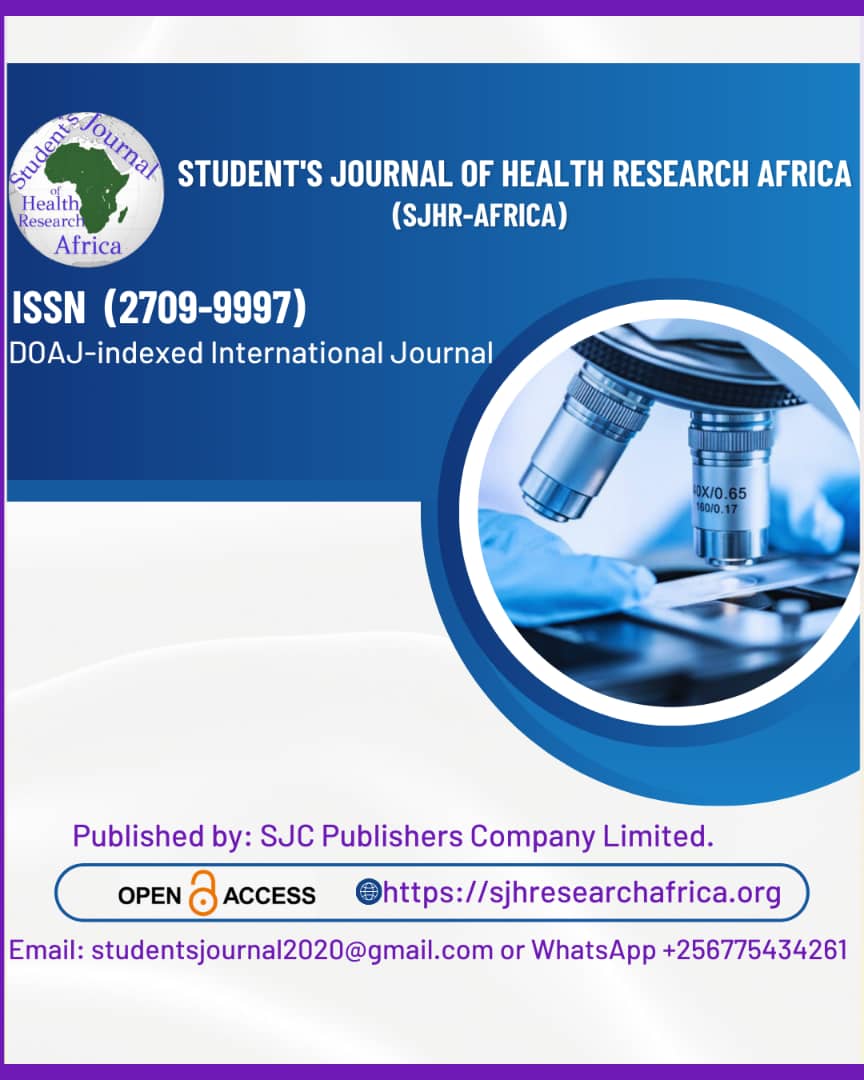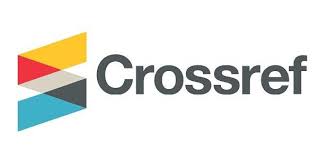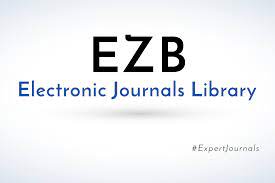Early detection of cerebral palsy in infants and young children using DDST II
DOI:
https://doi.org/10.51168/sjhrafrica.v5i11.1757Keywords:
Cerebral palsy, Young Children Using, InfantsAbstract
Background
Cerebral palsy (CP) encompasses a collection of enduring motor impairments resulting from non-progressive disruptions in the developing brain of a fetus or infant. Early detection is essential to commence prompt interventions that can greatly enhance functional outcomes and neurodevelopmental pathways.
Objective
To assess the efficacy of DDST II in the early identification of cerebral palsy in infants and young children at a tertiary care facility.
Methods
This observational study began in June 2022 at Jawaharlal Nehru Medical College & Hospital in Bhagalpur. One hundred infants and children, between 6 months to 2 years, with suspected developmental delays were assessed using the Denver Developmental Screening Test II (DDST II). Children designated as "suspect" or "untestable" received further assessment through neurological examination, neuroimaging (MRI), and follow-up consultations to validate the medical diagnosis of cerebral palsy (CP). The correlation between DDST II results and the clinical diagnosis of cerebral palsy was analyzed.
Results
Of the 100 children screened, 34 were categorized as "suspect" and 12 as "untestable" according to the DDST II. Out of these 46 children, 29 were ultimately diagnosed with cerebral palsy through clinical and radiological assessments. The DDST II exhibited a sensitivity of 93.5% and a positive predictive value of 63% in identifying children with cerebral palsy. Delays in gross motor and language skills characterize most cases of cerebral palsy. Children identified by DDST II received earlier therapeutic interventions than those diagnosed subsequently based solely on clinical suspicion.
Conclusion
DDST II serves as an efficient and practical screening instrument for the initial identification of cerebral palsy in infants and young children.
Recommendation
Incorporating it into standard developmental monitoring can assist in early diagnosis and timely intervention, particularly in resource-limited pediatric environments.
References
Rosenbaum P, Paneth N, Leviton A, et al. A report: The definition and classification of cerebral palsy. Dev Med Child Neurol Suppl. 2007;109:8–14.
Novak I, Morgan C, Adde L, et al. Early, accurate diagnosis and early intervention in cerebral palsy. JAMA Pediatr. 2017;171(9):897-907.
https://doi.org/10.1001/jamapediatrics.2017.1689
PMid:28715518 PMCid:PMC9641643
Himmelmann K, Uvebrant P. The panorama of cerebral palsy in Sweden. XI. Changing patterns in the birth-year period 2003-2006. Acta Paediatr. 2014;103(6):618-624.
https://doi.org/10.1111/apa.12614
PMid:24575788
Spittle A, Orton J, Anderson PJ, et al. Early developmental intervention programs post-hospital discharge to prevent motor and cognitive impairment in preterm infants. Cochrane Database Syst Rev. 2015;11:CD005495.
https://doi.org/10.1002/14651858.CD005495.pub4
PMid:26597166 PMCid:PMC8612699
Saini AG, Singhi P. Cerebral palsy: current concepts. Indian J Pediatr. 2019;86(1):1–8.
Frankenburg WK, Dodds JB, Archer P, et al. Denver II: Technical Manual. Denver Developmental Materials, 1992.
Bhatia V, Joseph A. Developmental screening and surveillance in India: Need of the hour. Indian Pediatr. 2019;56(7):553–558.
Sharma R, Goyal JP, Patel S, et al. Utility of DDST II in early diagnosis of developmental delay in infants. J Clin Diagn Res. 2013;7(11):2581–2583.
Aggarwal A, Ahuja B, Kabra M. Developmental delay: diagnosis and management. Indian J Pediatr. 2005;72(8):675–678.
Oskoui M, Coutinho F, Dykeman J, Jetté N, Pringsheim T. An update on the prevalence of cerebral palsy: a systematic review and meta-analysis. Dev Med Child Neurol. 2013;55(6):509-519.
https://doi.org/10.1111/dmcn.12080
PMid:23346889
Novak I, Morgan C, Fahey M, et al. State of the evidence traffic lights 2019: systematic review of interventions for preventing and treating children with cerebral palsy. Curr Neurol Neurosci Rep. 2020;20(2):3.
https://doi.org/10.1007/s11910-020-1022-z
PMid:32086598 PMCid:PMC7035308
Reilly S, Morgan A, Wake M. Identifying and managing common childhood language and speech impairments. BMJ. 2010;341:c4684.
Einspieler C, Prechtl HF, Bos AF, Ferrari F, Cioni G. Prechtl’s Method on the Qualitative Assessment of General Movements in Preterm, Term and Young Infants. Mac Keith Press; 2004.
Bhatia V, Juneja M. Utility of Denver II for early identification of developmental delay in North Indian children. Indian Pediatr. 2008;45(6):460–465.
Spittle A, Orton J. Cerebral palsy early intervention and the effectiveness of early diagnosis. J Pediatr Rehabil Med. 2014;7(2):131–142.
Morgan C, Fetters L, Adde L, et al. Early intervention for children aged 0 to 2 years with or at high risk of cerebral palsy: International clinical practice guideline. Dev Med Child Neurol. 2021;63(9):870–886.
Einspieler C, Bos AF, Libertus ME, Marschik PB. The general movement assessment helps in the early detection of cerebral palsy. Curr Opin Neurol. 2016;29(2):138–142.
Downloads
Published
How to Cite
Issue
Section
License
Copyright (c) 2024 Dr. Pankaj Kumar, Dr. Erum Yasmin, Dr. Kamran Fazal

This work is licensed under a Creative Commons Attribution-NonCommercial-NoDerivatives 4.0 International License.






















